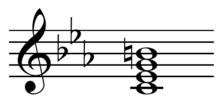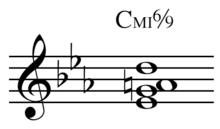Tonic (music)





In music, the tonic is the first scale degree of a diatonic scale and the tonal center or final resolution tone[4] that is commonly used in the final cadence in tonal (musical key-based) Classical music, popular music and traditional music. The triad formed on the tonic note, the tonic chord, is thus the most significant chord in these styles of music. More generally, the tonic is the pitch upon which all other pitches of a piece are hierarchically referenced. Scales are named after their tonics, thus the tonic of the scale of C is the note C. Simple folk music and traditional songs may begin and end on the tonic note.
In very much conventionally tonal music, harmonic analysis will reveal a broad prevalence of the primary (often triadic) harmonies: tonic, dominant, and subdominant (i.e., I and its chief auxiliaries a 5th removed), and especially the first two of these.— Berry (1976)[5]
The tonic is often confused with the root, which is the reference note of a chord, rather than that of the scale. The root of a chord is different from the tonic, because many different types of chords (e.g., ii, IV, V) have root notes, and these are not tonic chords. It is also represented with the Roman numeral I. The other types of chords are given different Roman numerals, such as ii for the chord built on the second scale degree, IV for the chord built on the fourth scale degree, V for the chord built on the fifth scale degree, and so on (note: these Roman numerals are referring to a Major key).
Importance and function
In western European tonal music (key-based music) of the 18th and 19th centuries, the tonic center was the most important of all the different tone centers which a composer used in a piece of music, with most pieces beginning and ending on the tonic, usually modulating to the dominant (the fifth above the tonic, or the fourth note down from the tonic) in between. Two parallel keys have the same tonic. For example, in both C major and C minor, the tonic is C. However, relative keys (two different scales that share a key signature) have different tonics. For example, C major and A minor share a key signature that feature no sharps or flats, despite having different tonic pitches (C and A, respectively).
Tonic may be reserved exclusively for use in tonal contexts while tonal center and/or pitch center may be used in post- and atonal music: "For purposes of non-tonal centric music, it might be a good idea to have the term 'tone center' refer to the more general class of which 'tonics' (or tone centers in tonal contexts) could be regarded as a subclass."[6] Thus a pitch center may function referentially or contextually in an atonal context, often acting as axis or line of symmetry in an interval cycle.[7] Pitch centricity was coined by Arthur Berger in his "Problems of Pitch Organization in Stravinsky".[8]
The tonic diatonic function includes 4 separate activities or roles as the principal goal tone, initiating event, generator of other tones, and the stable center neutralizing the tension between dominant and subdominant
See also
References
- ↑ Benward & Saker (2003). Music: In Theory and Practice, Vol. I, p.229. Seventh Edition. ISBN 978-0-07-294262-0.
- 1 2 Benward & Saker (2003), p.230.
- ↑ Berg, Shelly (2005). Alfred's Essentials of Jazz Theory, Book 3, p.90. ISBN 978-0-7390-3089-9.
- ↑ Benward & Saker (2003), p.33.
- ↑ Berry, Wallace (1976/1987). Structural Functions in Music, p.62. ISBN 0-486-25384-8.
- ↑ Berger (1963), p. 12. cited in Swift, Richard. "A Tonal Analog: The Tone-Centered Music of George Perle", p.258. Perspectives of New Music, Vol. 21, No. 1/2, (Autumn, 1982 - Summer, 1983), pp. 257-284.
- ↑ Samson, Jim (1977). Music in transition: a study of tonal expansion and atonality, 1900-1920. New York City: W. W. Norton & Company. ISBN 0-393-02193-9. OCLC 3240273.
- ↑ Berger, Arthur (Fall–Winter 1963). "Problems of Pitch Organization in Stravinsky". Perspectives of New Music. 2 (1): 11–42. doi:10.2307/832252. JSTOR 832252.